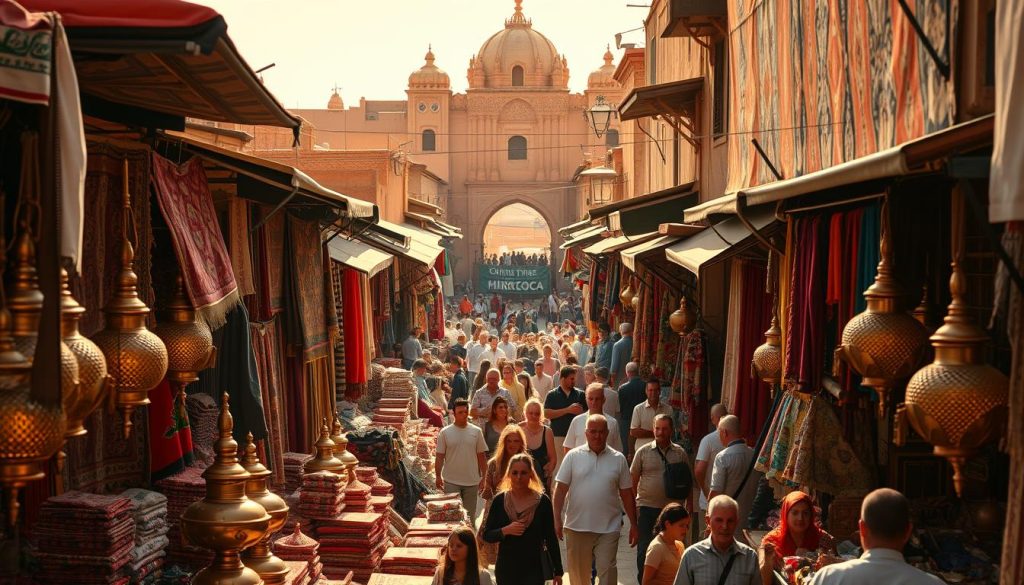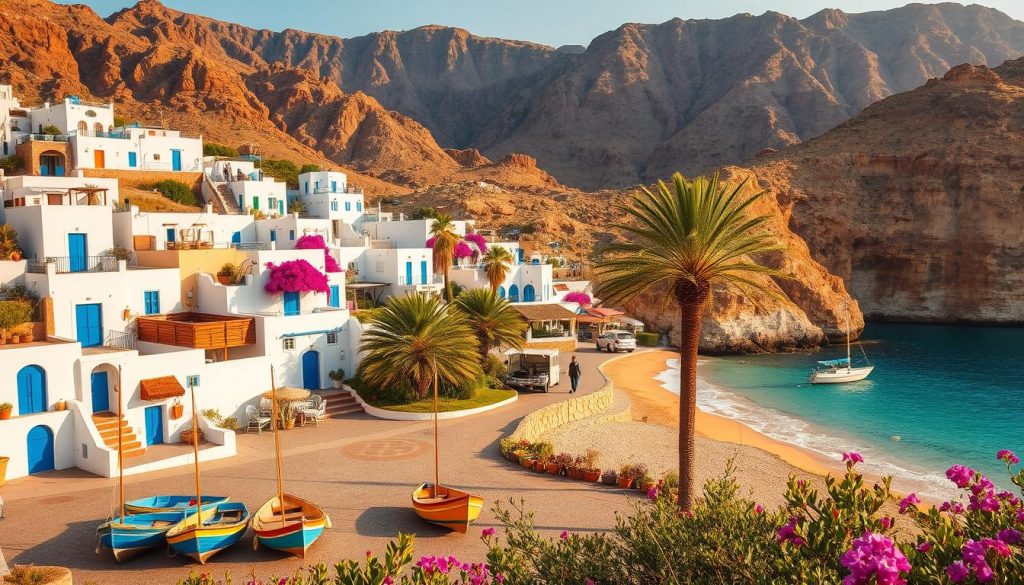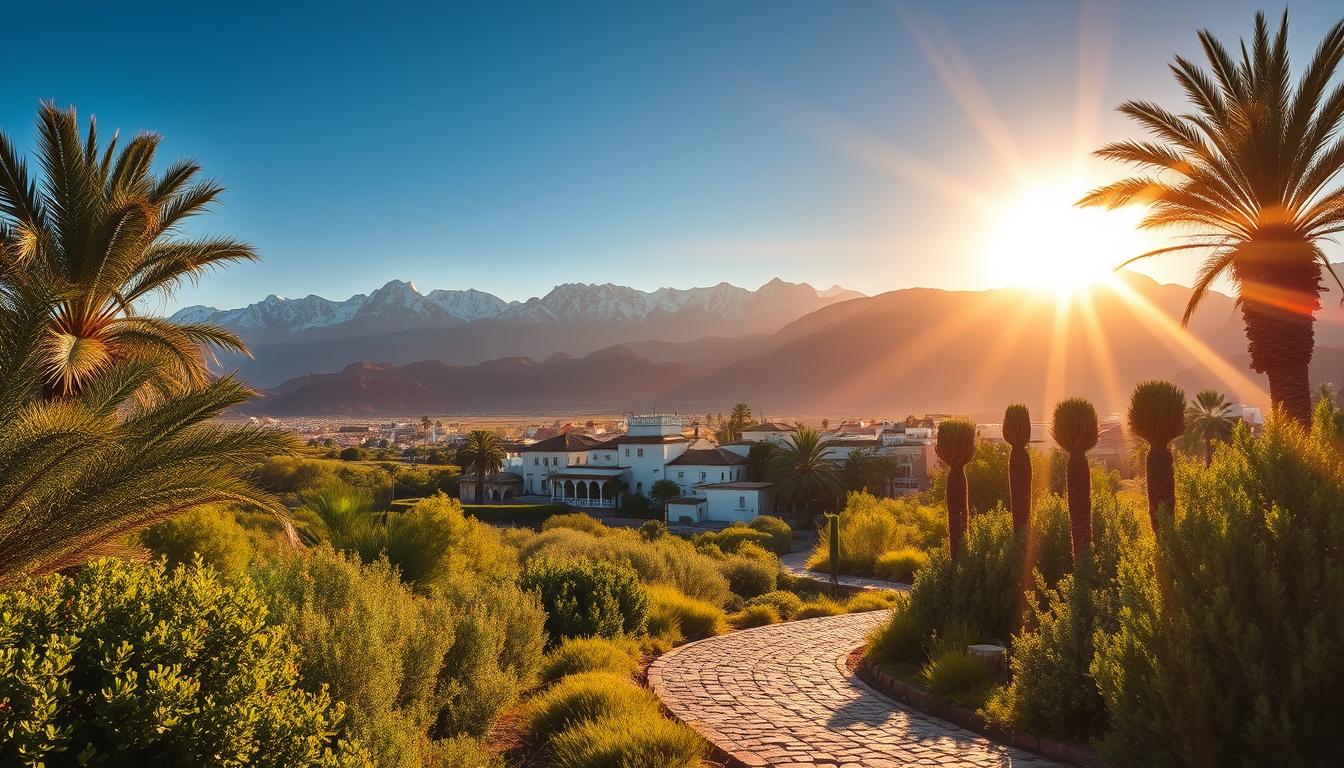Start an amazing Moroccan adventure that’s more than just a trip. Morocco mixes old traditions, lively cultures, and stunning views. You’ll find unforgettable moments in places off the usual path.
Looking for real experiences? Morocco has hidden spots that show its true self. Each area has its own secrets – from Atlas Mountains villages to coastal towns. Morocco’s magic is in its surprises and enchantments.
Get ready for a journey that’s more than a vacation. Moroccan adventures let you dive into local cultures, try amazing food, and see landscapes that are almost magical.
Key Takeaways
- Discover authentic Morocco beyond standard tourist routes
- Experience diverse landscapes from deserts to mountains
- Engage with rich cultural traditions and local communities
- Explore hidden gems in imperial cities and remote regions
- Create personalized travel experiences that go deeper than typical holidays
Planning Your Perfect Moroccan Adventure
Creating a memorable trip to Morocco needs careful planning. It’s not just about the places you visit. It’s about how you explore this vibrant North African country.
Best Time to Visit Morocco
Choosing the right time for your Moroccan trip can make all the difference. The best time depends on what you want to do and see.
- Spring (March-May): Mild temperatures, blooming landscapes
- Fall (September-November): Comfortable weather, fewer tourists
- Winter (December-February): Perfect for mountain and desert exploration
- Summer (June-August): Ideal for coastal regions, hot inland areas
Essential Travel Documents and Requirements
Knowing what you need for a smooth trip to Morocco is key. U.S. citizens must have certain documents to enter.
| Document | Requirement |
|---|---|
| Passport | Valid for at least 6 months beyond stay |
| Visa | Not required for stays under 90 days |
| Return Ticket | Recommended proof of departure |
Creating Your Morocco Itinerary
Planning a perfect Moroccan trip means finding the right mix of famous spots and hidden gems. Think about exploring cities, deserts, and coastlines to see it all.
- Research key destinations
- Allow flexible travel time
- Plan for cultural experiences
- Include off-the-beaten-path locations
Your trip should focus on real experiences, understanding the culture, and exploring on your own. Each area of Morocco has its own story to tell.
Top Hidden Gems in Morocco’s Imperial Cities
https://www.youtube.com/watch?v=HRzLiATNRNc&pp=ygUJI3NpdGV2aXNp
Exploring Morocco’s imperial cities opens a world of secret wonders. These historic places offer unique experiences off the beaten path. Here, ancient traditions and hidden spots await discovery.
Marrakech is a treasure trove of hidden gems. Travelers can find magical spaces that most miss:
- Secret Madrasa courtyards with intricate tile work
- Forgotten artisan workshops in narrow medina alleys
- Underground historical spaces rarely visited by tourists
In Fez, the city’s complexity reveals extraordinary hidden attractions. Visitors can explore:
- Restored medieval buildings with stunning architectural details
- Local craft workshops demonstrating centuries-old techniques
- Hidden museums showcasing Moroccan cultural heritage
| Imperial City | Hidden Attraction Type | Unique Experience |
|---|---|---|
| Marrakech | Private Courtyard Gardens | Architectural Meditation Spaces |
| Fez | Traditional Craft Workshops | Artisan Skill Demonstrations |
| Meknes | Underground Historical Passages | Royal Palace Exploration |
Travelers seeking authentic experiences in Morocco’s imperial cities should follow local guidance. Engage with community members and stay open to unexpected discoveries. The most memorable journeys often emerge from unplanned moments of cultural connection.
Authentic Moroccan Riads: Where to Stay Off the Beaten Path
Exploring Moroccan hospitality starts with staying in authentic riads. These traditional houses turned into boutique hotels offer a peek into Morocco’s culture. Unlike regular hotels, riads give a close-up look at Moroccan architecture.
Traditional Riad Architecture and Design
Moroccan riads are architectural wonders. They are known for their unique design, with:
- Intricately decorated interior walls
- Ornate tile work called zellige
- Central courtyard with water features
- Detailed wooden carvings and arches
Best Boutique Riads in Marrakech
Marrakech is the best place to experience Morocco’s true hospitality. The city has amazing riads that mix old charm with modern comfort.
| Riad Name | Location | Unique Feature |
|---|---|---|
| Riad Kniza | Medina | 16th-century restored palace |
| La Maison Arabe | Derb Assehbi | Cooking classes available |
| Riad Joya | Kennaria | Minimalist design with traditional elements |
Hidden Courtyard Gardens and Rooftop Terraces
The charm of Moroccan riads is in their hidden spots. Their lush gardens and big terraces offer quiet escapes from the city. Guests can relax, enjoy mint tea, and see amazing views.
Exploring Morocco’s Ancient Medinas and Souks

Step into the enchanting world of Morocco medinas. Here, centuries-old traditions come alive in narrow, winding streets. These historic urban centers pulse with energy, offering travelers an immersive journey through traditional Moroccan markets that have remained largely unchanged for generations.
Navigating the Moroccan souks requires a sense of adventure and some strategic tips:
- Embrace the art of gentle negotiation
- Learn basic Arabic or French phrases
- Carry cash in small denominations
- Dress respectfully and comfortably
Marrakech and Fez boast the most iconic medinas, where sensory experiences overwhelm visitors. The intricate craftsmanship of local artisans transforms these markets into living museums. Handwoven carpets, detailed metalwork, aromatic spices, and vibrant ceramics create a kaleidoscope of colors and textures.
Hidden corners of these traditional Moroccan markets reveal unexpected treasures. Local craftsmen demonstrate age-old techniques passed down through generations, inviting curious travelers to witness authentic cultural practices.
Pro tip: The best experiences come from wandering without a strict agenda. Let the maze-like streets guide you, and you’ll discover remarkable moments that transform a simple market visit into an unforgettable cultural journey.
Desert Adventures: Beyond the Tourist Trail
The Sahara Desert Morocco is a world of endless golden sands and rich culture. It offers a journey that goes beyond typical tourist paths. Here, travelers find the true heart of Moroccan wilderness.
Exploring the Sahara is more than just a tour. It’s about diving into unique experiences. These experiences connect you with the desert’s beauty and culture.
Secret Oases in the Sahara
These hidden green havens are a surprise for adventurous travelers. Some amazing oases include:
- Taghit Oasis with its ancient rock carvings
- Figuig Oasis featuring historic palm gardens
- Tinghir Oasis nestled between dramatic mountain ranges
Authentic Berber Camps and Experiences
Morocco desert tours offer a chance to dive into Berber culture. These experiences let travelers:
- Stay in traditional nomadic camps
- Learn traditional handicraft techniques
- Share meals with local Berber families
Desert Photography Spots
Photographers will love the Sahara Desert Morocco. It’s a perfect place for capturing stunning landscapes. Some top spots include:
| Location | Best Time | Unique Feature |
|---|---|---|
| Erg Chebbi Dunes | Sunrise/Sunset | Massive golden sand formations |
| Merzouga Desert | Early Morning | Camel caravan silhouettes |
| Zagora Desert | Late Afternoon | Dramatic rocky landscapes |
These experiences and adventures connect travelers deeply with Morocco’s wilderness. They turn a simple trip into a memorable journey of discovery.
Coastal Escapes: Morocco’s Lesser-Known Beach Towns

Morocco’s coast is full of hidden beach towns that few tourists know about. These places offer a real taste of Morocco, away from busy resorts. They show the beauty of North Africa’s coast.
Exploring Morocco’s beaches means going off the beaten path. Small fishing villages along the coast offer a chance to see real culture and beauty.
- Taghazout: A surfer’s paradise with incredible wave conditions
- Oualidia: Known for pristine oyster farms and tranquil lagoons
- Essaouira: A historic port town with wind-swept beaches
Travelers can enjoy these hidden spots through many activities. These activities highlight local culture and nature.
| Beach Town | Key Attractions | Best Season to Visit |
|---|---|---|
| Taghazout | World-class surfing, yoga retreats | September-April |
| Oualidia | Oyster tasting, birdwatching | May-October |
| Essaouira | Historic medina, wind sports | June-September |
Each coastal town in Morocco offers something special. From fresh seafood markets to beaches for photos, these towns are perfect for the adventurous. They invite travelers to see Morocco’s coast in a new way.
Mountain Retreats: Atlas Mountains’ Secret Spots
The Atlas Mountains in Morocco are a hidden gem. They offer a peaceful escape from the usual tourist spots. These mountains are perfect for those who love nature and want to dive into local culture.
Hidden Berber Villages
The Atlas Mountains are home to untouched Berber villages. These villages keep their traditions alive, giving visitors a rare look into a different way of life.
- Experience traditional stone houses built into mountainsides
- Interact with local Berber families
- Learn about centuries-old cultural practices
Trekking Routes for All Levels
There’s a trek for everyone in the Atlas Mountains. Whether you’re looking for a leisurely stroll or a challenging climb, you’ll find it here. The views are simply stunning.
- Beginner Trails: Gentle paths around Imlil village
- Intermediate Routes: Toubkal National Park trails
- Advanced Treks: Mount Toubkal summit expedition
Local Mountain Cuisine
Berber villages are known for their delicious food. It’s made with local ingredients and traditional methods. You’ll love the flavors.
- Tagine prepared with mountain herbs
- Fresh goat cheese from local herds
- Traditional mint tea ceremonies
Traditional Moroccan Cuisine: Local Food Experiences
Moroccan cuisine is a mix of flavors from Berber, Arabic, and Mediterranean traditions. Food tours in Morocco take you on a journey through aromatic spices and slow-cooked tagines. These dishes have been passed down through generations.
Exploring Moroccan dishes shows a rich food scene. You can find unique dishes from different regions. These dishes highlight the country’s diverse food heritage.
- Tagine: Slow-cooked stew with meat and vegetables
- Couscous: Steamed semolina with meat and vegetable accompaniments
- Pastilla: Sweet and savory meat pie with phyllo pastry
- Harira: Traditional Moroccan soup
Food lovers can have real experiences through:
- Local cooking classes
- Market tours in ancient medinas
- Family dining experiences
- Street food adventures
| Region | Signature Dish | Key Ingredients |
|---|---|---|
| Marrakech | Tanjia | Beef, preserved lemons, cumin |
| Fez | Pastilla | Pigeon meat, almonds, cinnamon |
| Coastal Regions | Seafood Tagine | Fresh fish, saffron, herbs |
Moroccan cuisine is more than just food—it’s a cultural experience. It connects travelers with local traditions and hospitality.
Holidays In Morocco: Cultural Immersion Tips
Exploring Morocco’s heart is more than just visiting places. It’s about diving deep into the culture and respecting local ways. By doing this, your trip can become a unique adventure filled with cultural experiences.
- Learn basic Arabic or Berber greetings to show respect
- Dress modestly, especially in rural and traditional areas
- Always ask permission before photographing people
- Practice cultural sensitivity during religious observances
Knowing a bit of Arabic or Berber can make a big difference. Many Moroccans speak French and some English too. But, learning phrases like Salaam alaikum (peace be upon you) shows you care and respect.
Connecting with locals takes patience and a real interest in their lives. Try joining in on:
- Cooking classes with local families
- Artisan workshops in medinas
- Community-based tourism experiences
- Local festival celebrations
Showing respect for local traditions makes your trip unforgettable. It’s more than just seeing sights; it’s about experiencing the culture firsthand.
Conclusion
Morocco is a place full of vibrant experiences, beyond what most tourists see. With the right travel tips and planning, you can have an amazing adventure. From Marrakech’s busy medinas to the calm Sahara Desert, every spot offers something special.
Exploring Morocco’s local cultures and hidden spots is key to unforgettable experiences. You might find yourself in ancient riads, trekking the Atlas Mountains, or enjoying Berber hospitality. Each moment is a memory to cherish. By understanding local customs and staying open-minded, your trip becomes more than just a vacation.
When planning your Morocco trip, aim for diversity and authenticity. Be ready for the locals’ warmth, the rich food, and the changing landscapes. Traveling with curiosity and respect will make your experience deep and lasting.
The magic of Morocco is waiting for you to discover. Start planning your trip, bring your sense of wonder, and get ready for an adventure that will change you.

